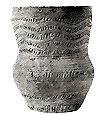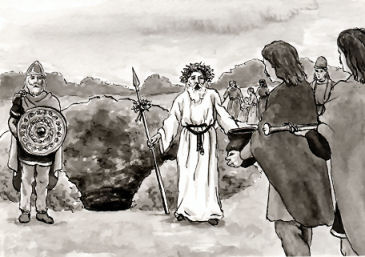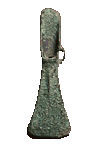

|
The introduction of metal working can be dated to around 2000BC in Britain, and signified the arrival of the Bronze Age, which was already in full swing in Europe. Although not certain, it is generally thought that the new bronze tools and weapons identified with this age were brought over from the continent by the Bell Beaker Folk, so called because of their distinctive bell shaped pottery drinking vessels. They probably came up through Cornwall, which at the time had rich deposits of copper and tin, and readily mixed with any new culture they encountered, including the Neolithic farmers they found in Britain. These people were not only skilled potters producing fine earthenware vessels, but also bought with them the skill and knowledge of producing and using bronze, and Bronze was a metal hard enough to hold an edge, and that meant a revolution in tools and weapons. The first items were produced about 2,000BC in gold, then in copper. Both metals were too soft to produce goods of great practical use, and the objects made must be considered as luxury goods owned only by the wealthier members of society. The situation was made worse by the introduction of metalworking to Britain from the Continent. A more durable product resulted when copper was combined with tin to produce bronze, giving rise to the name of this period, the Bronze Age. An elite warrior class can be distinguished at this time, seen mainly through their burial customs. When members of this class died, they were usually cremated and their ashes placed in urns. Large mounds were built over the remains and examples of these are what we see on Witheridge Moor and Dart Raffe Moor, as well as Gibbet Moor and near Gidley Cross. The mounds are generally known as barrows, and from examples excavated elsewhere many exotic and prized possessions were found with the remains, underlining the fact that these were the tombs of the uppermost class of Bronze Age society.
None of the local barrows have been investigated - at least, not legally! - So we have no clues as to who lies buried there. Their survival in large numbers on higher ground could be just due to the fact that in most cases this land has not been used for agricultural purposes; therefore they have remained largely undisturbed. They also probably served as boundary markers between different tribal groups, and could have been placed so that the spirits of the dead warriors were thought to defend the territory of the tribe. Textile production had also started by this time. Women wore long woollen skirts and short tunics, whilst the men wore knee length wrap around skirts or kilt like woollens, as well as tunics, cloaks and even one-piece garments. They were also clean-shaven, long-haired and wore round woollen hats. The standard farming household consisted of two houses, a main living house and an outhouse for cooking and textile production. The dead were cremated and buried in small cemeteries behind each settlement. The large burial sites of the early Bronze Age were a thing of the past. The land was now too important for agricultural use. During the Neolithic Period, the burial rights tended to be collective, with all the members of a group being buried together over a long period, in one site (long barrows, chamber tombs etc.). With the arrival of the Bronze Age this changed and we saw the introduction of cremation of the dead and burials in round barrows, often with their prized possessions. Examples of these mounds or barrows can be seen on Witheridge Moor, Dart Raffe Moor, and Gibbet Moor, and also near Gidley Cross. None of these local barrows have been investigated, at least legally, so we have no idea as to who lies buried there. Their survival in large numbers on higher ground could be due to the simple fact that in most cases this land has not been used for agricultural purposes, therefore they have remained largely undisturbed. There are three Bronze Age barrows (burial Mounds) on Dart Raffe Moor, lying parallel to, and south of, the road from Doorpark to Wheadon Cross. This group of barrows are nationally important and as such, all three have been designated as Scheduled Ancient Monuments. The smallest measures 27 paces across, and stands about 3 foot high, whilst the largest at 36 paces stands at about 5 foot high and shows signs of the original surrounding ditch. Barrows were constructed by digging a circular ditch and after the remains had been placed in the centre, the soil was piled on top to form a mound. Over time mounds would erode away and the ditches fill up. The other group of barrows are usually described as being on Witheridge Moor, although the westernmost example is on agricultural land west of the road that runs from Five Crosses to Elworthy Cross. This group is of similar size to the Dart Raffe examples, ranging in width from 28 to 35 paces across and from 3 foot to 6 foot in height, apart from one which is only 1 foot tall, and appears to have been damaged by ploughing in the past.
One thing that sets the Witheridge Moor barrows apart, is that one of them, the easternmost, is associated with two, if not three, large stones. Standing stones were by no means unusual in the Bronze Age, but it is not too common to find them so close to barrows. The Witheridge stones have remained largely unnoticed largely because they lie flat on the ground, and are often hidden by vegetation. Of the two stones which lie close to the barrow, the largest is over 6 foot long and nearly 6 foot wide, while the other measures about 4 foot by 2 foot. The third stone is to be found further to the east, across the north south road that divides Witheridge Moor. Whilst doubts have been cast on its links to the other two, there is no apparent good reason. Although it is pure speculation, it has been suggested that these stones could have once formed part of a larger ritual monument, perhaps even a stone circle. Were there originally more barrows? If there were any on lower ground more suited to cultivation then their chances of survival would not have been very good. To emphasise this, aerial photographs have shown signs of three ring-ditches near Bourne Park at Meshaw, which have been interpreted as the sort that surround barrows. Nor were barrows always used as a means of burial. A chance discovery was made while ploughing on Lower Ash Moor Farm, Rose Ash, in 1980, of a 12-inch high urn. This contained the cremated remains of an adult human, and was dated to about 1050 BC, placing it firmly within the Bronze Age. The urn had been placed in a small pit and covered by a capstone, but there was no suggestion of a covering mound. But both of these types of burial would have been reserved for the warrior-class and their family: the rest of society would probably have been accorded little, if any, ceremony. Unfortunately, despite all this evidence, no settlements of the people who built the barrows have yet been discovered. However, some flint tools have been found close to the Gibbet Moor barrows, suggesting a nearby habitation site. Previous Last Edited 03/07/2006 Copyright © 2000-2006 Witheridge Unless otherwise indicated on the page in question, the photographic images reproduced on this site belong to the Witheridge Archives, and, as such may not be reproduced for commercial purposes without written permission. However, you are welcome to use any of the photographs belonging to the archive for personal and/or non-commercial use. Any material shown as not being owned by the archive may not be reproduced in any form without first receiving written permission from the owner of the material in question. The copyright for the illustration of the Construction of a Barrow belongs to Witheridge Artist and Illustrator Jenny Bidgood. That of the Bronze Axe head is reproduced courtesy of Devon County Council. |




